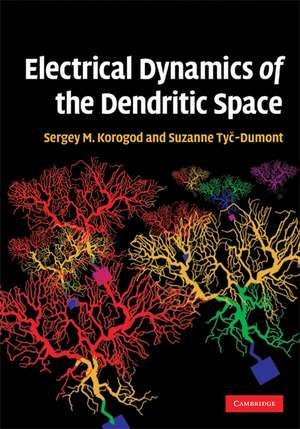Electrical Dynamics of the Dendritic Space
Autor Sergiy Mikhailovich Korogod, Suzanne Tyč-Dumonten Limba Engleză Hardback – 16 dec 2009
Preț: 451.96 lei
Preț vechi: 507.82 lei
-11% Nou
Puncte Express: 678
Preț estimativ în valută:
86.48€ • 90.30$ • 71.41£
86.48€ • 90.30$ • 71.41£
Carte tipărită la comandă
Livrare economică 15-29 aprilie
Preluare comenzi: 021 569.72.76
Specificații
ISBN-13: 9780521896771
ISBN-10: 0521896770
Pagini: 224
Ilustrații: 3 b/w illus. 14 colour illus.
Dimensiuni: 180 x 254 x 16 mm
Greutate: 0.61 kg
Editura: Cambridge University Press
Colecția Cambridge University Press
Locul publicării:Cambridge, United Kingdom
ISBN-10: 0521896770
Pagini: 224
Ilustrații: 3 b/w illus. 14 colour illus.
Dimensiuni: 180 x 254 x 16 mm
Greutate: 0.61 kg
Editura: Cambridge University Press
Colecția Cambridge University Press
Locul publicării:Cambridge, United Kingdom
Cuprins
1. Definition of the neuron; 2. 3D geometry of dendritic arborizations; 3. Basics in bioelectricity; 4. The cable theory and the dendrites; 5. Voltage transfer over the dendrites; 6. Current transfer over dendrites; 7. Electrical structure of an artificial dendritic path; 8. Electrical structure of a bifurcation; 9. Geography of the dendritic space; 10. Electrical structures of biological dendrites; 11. Electrical structure of the whole arborization; 12. Electrical structures in the 3D dendritic space; 13. Dendritic space as coder of the temporal output patterns; 14. Concluding remarks.
Recenzii
'Dendritic trees come in all sorts of shapes and sizes. Their complexity and diversity lends a majesty and beauty to the task of understanding the brain. But are they more than just random protrusions? Could their very complexity and diversity be important for the computational properties of the brain? The authors are clear on this point, 'We strongly believe that the answer is yes indeed, as we attribute a specific role to every of these structural features in a harmonious working ensemble!' I am sure that readers of this book will also be convinced. The book progresses through careful treatment of the electrical properties of dendrites to how the geometry interacts with synaptic input to produce rich repertoires of firing output. It is an important book for experts and students of dendrites alike as well as an eye-opener for neuroscientists in every field.' Matthew Larkum, University of Bern
'Electrical Dynamics of the Dendritic Space is a compelling treatise on the electrical properties of neuronal dendrites, from a modeling perspective. The authors Serge Korogod and Suzanne Tyč-Dumont do a super job in writing comprehensively on a topic of profound relevance to present day neuroscience.' Rodolfo Llinas, New York University Medical School
'The complex geometry of neuronal dendrites is one of the greatest challenges facing neuroscientists today. Serge Korogod and Suzanne Tyc-Dumont characterize the dendrites as an immense unknown. They have been pioneers in exploring this frontier. In this book they have distilled lifetimes of work by themselves and colleagues in France and the Ukraine to formulate new rules for how the electrical states of dendritic arborizations represent space and time in generating the neural code. In clear language they show how the interactions between these passive and active properties and dendritic geometry create different scales of dynamical dendritic space. New insights are provided into the significance of the dendrites of motoneurons, cerebellar Purkinje cells, and cortical pyramidal neurons. Their models available online give dramatic evidence for these insights. This is a key book for all those interested in dendrites and in the neural basis of cognition and behavior.' Gordon M. Shepherd, Yale University School of Medicine
'Electrical Dynamics of the Dendritic Space is a compelling treatise on the electrical properties of neuronal dendrites, from a modeling perspective. The authors Serge Korogod and Suzanne Tyč-Dumont do a super job in writing comprehensively on a topic of profound relevance to present day neuroscience.' Rodolfo Llinas, New York University Medical School
'The complex geometry of neuronal dendrites is one of the greatest challenges facing neuroscientists today. Serge Korogod and Suzanne Tyc-Dumont characterize the dendrites as an immense unknown. They have been pioneers in exploring this frontier. In this book they have distilled lifetimes of work by themselves and colleagues in France and the Ukraine to formulate new rules for how the electrical states of dendritic arborizations represent space and time in generating the neural code. In clear language they show how the interactions between these passive and active properties and dendritic geometry create different scales of dynamical dendritic space. New insights are provided into the significance of the dendrites of motoneurons, cerebellar Purkinje cells, and cortical pyramidal neurons. Their models available online give dramatic evidence for these insights. This is a key book for all those interested in dendrites and in the neural basis of cognition and behavior.' Gordon M. Shepherd, Yale University School of Medicine
Notă biografică
Descriere
Exploration of the role of dendritic geometry in shaping the electric dendritic field of the neuron. With NeuronViewer and user guide.









